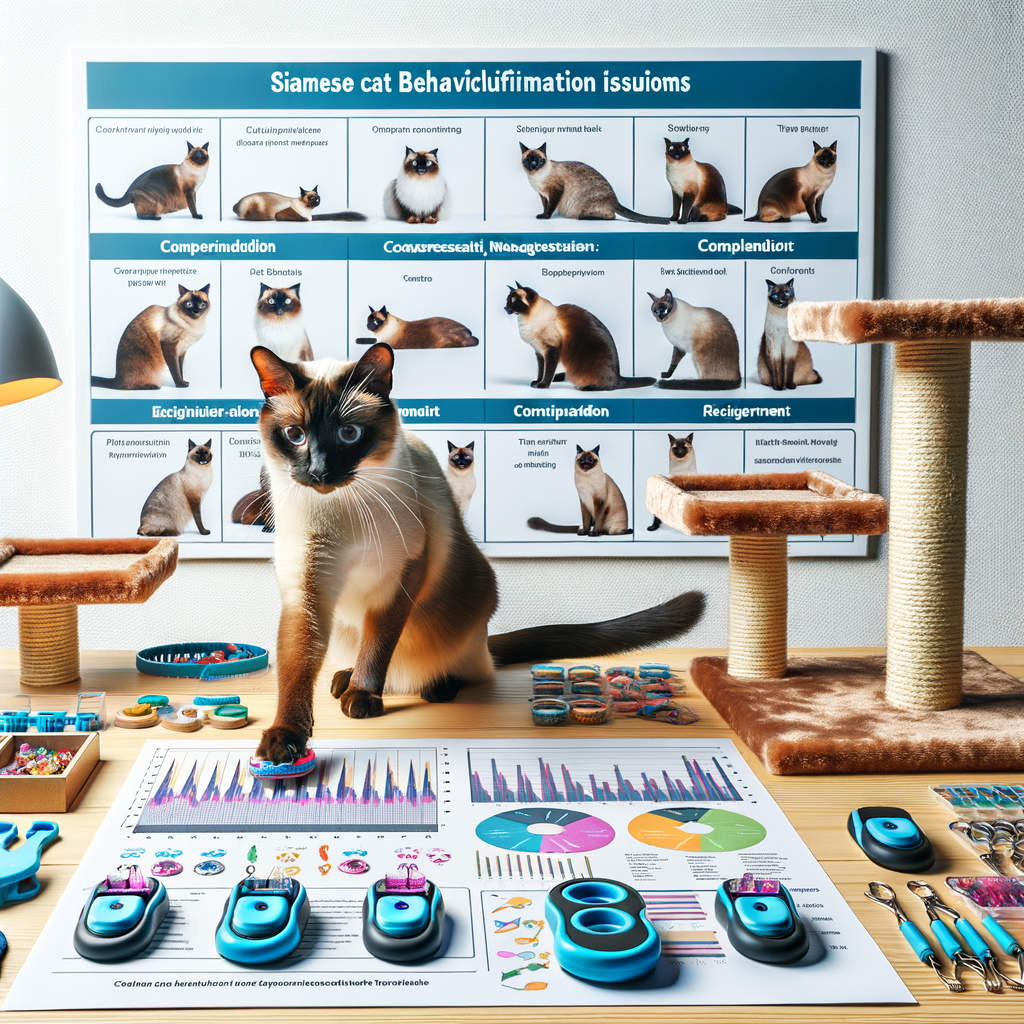
Introduction to Siamese Cat Behavior
Siamese cats are known for their striking features and unique personalities. They are one of the oldest breeds of domestic cats and have a rich history that contributes to their behavior. Understanding their behavior not only helps in building a stronger bond with them but also aids in addressing any behavioral problems that may arise.
-
Understanding Siamese Cat Behavior
Siamese cats are known for their social, playful, and intelligent nature. They are often described as “dog-like” because they enjoy playing fetch, following their owners around, and even responding to voice commands. They are also known for their vocal nature. They have a wide range of vocalizations and aren’t shy about using them to communicate their needs and desires.
Siamese cats are also very affectionate. They form strong bonds with their human families and often choose a favorite person to whom they devote their love and attention. They are also known to get along well with other pets, especially if they are introduced properly.
These cats are also known for their curiosity. They love to explore their surroundings and can often be found perched on high places, observing the world around them. This curiosity, combined with their intelligence, often leads them to figure out how to open cabinets, doors, and even windows.
-
Common Siamese Cat Behavior Problems
While Siamese cats are generally well-behaved, they can develop certain behavior problems. One common issue is excessive vocalization. While it’s normal for Siamese cats to be talkative, excessive meowing can sometimes be a sign of boredom, stress, or even illness.
Siamese cats can also be prone to separation anxiety due to their social nature. They don’t like being left alone for long periods and can become stressed or anxious, leading to behaviors like excessive meowing, destructive behavior, or inappropriate elimination.
Another common behavior problem in Siamese cats is aggression. This can be towards other pets or even humans. Aggression in cats can be caused by a variety of factors, including fear, stress, territorial disputes, or health problems.
It’s important to remember that any sudden changes in your cat’s behavior should be discussed with a veterinarian to rule out any underlying health issues.
Siamese Cat Training
Training your Siamese cat can be a fun and rewarding experience. With the right techniques, you can teach your feline friend to follow commands and even perform tricks. Let’s explore some basic training techniques that are effective for Siamese cats.
Basic Training Techniques
There are two fundamental techniques that you can use to train your Siamese cat. These are positive reinforcement and clicker training. Both methods are humane and enjoyable for your cat, promoting a positive relationship between you and your pet.
- Positive Reinforcement
- Clicker Training
Positive reinforcement is a technique where you reward your cat for performing a desired behavior. This could be anything from using the litter box correctly to responding to their name. The reward can be a treat, a toy, or even just a loving stroke. According to a study by the Journal of Feline Medicine and Surgery, cats respond well to positive reinforcement, making it an effective training method.
Clicker training is another popular method. It involves using a small device that makes a ‘click’ sound. You click the device and immediately reward your cat when they perform the desired behavior. Over time, your cat will associate the ‘click’ with the reward and will perform the behavior when they hear the sound. This method is widely used in animal training and has been proven to be effective for cats as well.
In conclusion, training your Siamese cat can be a fun and rewarding experience for both of you. By using positive reinforcement and clicker training, you can teach your cat to follow commands and even perform tricks. Remember, patience and consistency are key in any training process. Happy training!
Advanced Training Techniques
After mastering the basics, it’s time to move on to more advanced training techniques for your Siamese cat. These techniques will further enhance your cat’s skills and behavior. Let’s explore two of these techniques: Target Training and Agility Training.
-
Target Training
Target training is a method where you use a target, like a stick with a ball at the end, to guide your cat’s movements. This technique is highly effective for teaching your Siamese cat new tricks or behaviors.
For instance, you can use the target to guide your cat to jump through a hoop or to climb a cat tree. The key is to reward your cat each time it follows the target correctly. This could be with a treat, praise, or a clicker if you’re also using clicker training.
Remember, patience is key. It may take several sessions before your cat fully understands what you want it to do. But once it does, you’ll have a new and fun way to interact with your pet.
-
Agility Training
Agility training is another advanced technique that can be very beneficial for Siamese cats. This type of training involves creating an obstacle course for your cat to navigate. The course could include tunnels, jumps, and weave poles.
Agility training not only provides physical exercise but also stimulates your cat’s mind. It can help improve your cat’s balance, coordination, and confidence. Plus, it’s a great way for you and your cat to bond.
Start with simple obstacles and gradually increase the difficulty as your cat gets better. Always ensure the safety of your cat while training. And of course, reward your cat for a job well done!
In conclusion, advanced training techniques like target training and agility training can greatly enhance your Siamese cat’s skills and behavior. They provide a fun and engaging way to interact with your cat while also improving its physical and mental well-being. Remember, patience and consistency are key in any training regimen. Happy training!
Cat Behavior Modification
When it comes to understanding our feline friends, cat behavior modification plays a crucial role. It’s a method that helps us communicate better with our cats, making their lives and ours more harmonious. Let’s delve deeper into this topic.
Understanding Behavior Modification
Behavior modification is a systematic approach to change a cat’s behavior. It’s based on the principles of learning theory, which suggests that behavior is influenced by the consequences that follow. By understanding these principles, we can guide our cats towards better behavior.
- Principles of Cat Behavior Modification
- Benefits of Cat Behavior Modification
The principles of cat behavior modification are straightforward. They involve understanding the cat’s behavior, identifying the triggers, and then using positive reinforcement to encourage good behavior. For example, if your cat has a habit of scratching furniture, you can provide an alternative like a scratching post and reward your cat when it uses the post instead of the furniture.
The benefits of cat behavior modification are numerous. It can help eliminate undesirable behaviors, improve your cat’s mental health, and strengthen your bond with your cat. By using behavior modification techniques, you can create a peaceful and happy environment for both you and your cat.
In conclusion, understanding and applying the principles of cat behavior modification can significantly improve your relationship with your Siamese cat. It’s a gentle and effective way to guide your cat towards better behavior, making your shared home a more peaceful place.
Behavior Modification Techniques
When it comes to modifying the behavior of your Siamese cat, there are two main techniques that you can use. These are Counter Conditioning and Desensitization. Let’s delve deeper into each of these techniques.
- Counter Conditioning
- Desensitization
Counter Conditioning is a technique that involves changing your cat’s emotional response or behavior to a particular trigger. For instance, if your Siamese cat reacts negatively to the sight of a vacuum cleaner, you can use counter conditioning to change this reaction.
Here’s how it works: Start by identifying the trigger – in this case, the vacuum cleaner. Next, pair the trigger with something your cat loves, like a favorite toy or treat. Over time, your cat will start associating the trigger with positive experiences, effectively changing their behavior.
Desensitization is another effective behavior modification technique. It involves gradually exposing your cat to a trigger that causes fear or anxiety, in small, manageable doses.
For example, if your Siamese cat is afraid of loud noises, start by exposing them to the noise at a very low volume. Gradually increase the volume over time, allowing your cat to become accustomed to the noise. This process helps to reduce fear and anxiety, leading to a change in behavior.
Remember, patience is key when using these techniques. Behavior modification takes time, but with consistency, you’ll start to see positive changes in your Siamese cat’s behavior.
Siamese Cat Discipline
Disciplining a Siamese cat is a delicate process that requires patience and understanding. Siamese cats are known for their intelligence and strong will, which can make discipline a challenge. However, with the right techniques, you can effectively guide your Siamese cat towards better behavior. Let’s explore some effective discipline techniques and what to avoid when disciplining a Siamese cat.
- Effective Discipline Techniques
- Positive Reinforcement: Reward your Siamese cat when they behave well. This could be with treats, praise, or extra playtime. This encourages them to repeat the good behavior.
- Redirection: If your Siamese cat is engaging in unwanted behavior, redirect their attention to something more appropriate. For example, if they are scratching furniture, provide a scratching post.
- Consistency: Be consistent with your rules and expectations. If you allow a behavior one day and punish it the next, your Siamese cat will become confused.
- What to Avoid When Disciplining a Siamese Cat
- Physical Punishment: Never hit or physically harm your Siamese cat. This will only create fear and mistrust.
- Yelling: Yelling or shouting can scare your Siamese cat and can lead to more unwanted behavior. Instead, use a firm, calm voice to express disapproval.
- Ignoring Bad Behavior: Ignoring bad behavior won’t make it go away. Address it immediately and consistently to teach your Siamese cat that it’s not acceptable.
Discipline should always be about teaching and guiding, not punishing. Here are some effective techniques:
While discipline is important, there are certain methods that should be avoided. These include:
In conclusion, disciplining a Siamese cat requires patience and understanding. Always remember that discipline is about teaching, not punishing. With the right techniques, you can guide your Siamese cat towards better behavior.
Cat Behavior Management
Managing your cat’s behavior is an essential part of ensuring a harmonious relationship between you and your feline friend. It’s not just about correcting bad habits; it’s also about preventing behavior problems from developing in the first place. Let’s explore some effective strategies for preventing behavior problems in cats.
Preventing Behavior Problems
Preventing behavior problems in cats involves creating a supportive environment that caters to their natural instincts and needs. Two key aspects of this are environmental enrichment and regular exercise.
-
Environmental Enrichment
Environmental enrichment involves making your cat’s surroundings stimulating and engaging. This can be achieved by providing a variety of toys, scratching posts, and climbing trees. It’s also beneficial to have interactive play sessions with your cat. According to a study by the American Veterinary Medical Association, cats with enriched environments are less likely to develop behavior problems.
-
Regular Exercise
Regular exercise is another crucial aspect of preventing behavior problems in cats. Exercise helps to keep your cat physically fit and mentally stimulated. It can be as simple as playing fetch with a toy mouse or having your cat chase a laser pointer. The American Society for the Prevention of Cruelty to Animals recommends at least 15 minutes of active play per day for adult cats.
In conclusion, a combination of environmental enrichment and regular exercise can go a long way in preventing behavior problems in cats. Remember, a happy and stimulated cat is less likely to develop unwanted behaviors.
Managing Existing Behavior Problems
Even with the best efforts, sometimes Siamese cats can develop behavior problems. It’s important to remember that it’s never too late to manage these issues. Here are two effective ways to handle existing behavior problems in your Siamese cat:
- Professional Help
- Medication
Seeking professional help is often a good first step in managing your Siamese cat’s behavior problems. A certified animal behaviorist or a professional cat trainer can provide valuable insights into your cat’s behavior. They can help identify the root cause of the problem and suggest effective strategies to address it.
For example, if your Siamese cat is showing signs of aggression, a professional might suggest techniques to redirect this behavior. They might also recommend changes in your cat’s environment or daily routine to reduce stress and anxiety.
In some cases, medication may be necessary to manage your Siamese cat’s behavior problems. It’s important to understand that medication should be used as a last resort and always under the supervision of a veterinarian.
Medication can help manage issues like excessive grooming, aggression, or anxiety. For instance, a cat with severe anxiety might benefit from a short-term course of anti-anxiety medication. Remember, medication should be used in conjunction with behavioral modification techniques for the best results.
In conclusion, managing existing behavior problems in Siamese cats requires patience and understanding. Whether you choose to seek professional help or consider medication, always remember that the goal is to improve your cat’s quality of life and strengthen your bond with them.
Siamese Cat Behavior Tips
Understanding your Siamese cat’s behavior is crucial to building a strong bond and ensuring a healthy, happy pet. Here are some tips to help you navigate the unique world of Siamese cat behavior.
-
Understanding Your Siamese Cat’s Body Language
Siamese cats are known for their expressive body language. They use their ears, tail, and even their whiskers to communicate their feelings. For example, a relaxed Siamese cat will have its tail loosely curled around its body, while a scared or anxious cat may puff up its tail.
Similarly, a Siamese cat’s ears can tell you a lot about its mood. Ears that are forward and relaxed indicate a content cat, while ears that are flattened against the head may indicate fear or aggression. Paying attention to these subtle cues can help you understand your Siamese cat’s needs and emotions.
-
Building a Strong Bond with Your Siamese Cat
Building a strong bond with your Siamese cat involves understanding their unique personality traits and catering to their specific needs. Siamese cats are known for their social, affectionate nature. They crave interaction and attention from their owners.
Spending quality time with your Siamese cat, whether it’s through play, grooming, or simply sitting together, can help strengthen your bond. Remember to respect their boundaries and allow them to initiate contact when they feel comfortable. This will help build trust and deepen your relationship with your Siamese cat.
In conclusion, understanding your Siamese cat’s body language and building a strong bond through quality time and respect are key to a happy and healthy relationship with your pet. With these tips, you’ll be well on your way to becoming an expert in Siamese cat behavior.
Tools for Training Siamese Cats
Training your Siamese cat can be a rewarding experience, but it’s essential to have the right tools at your disposal. Here are some of the most effective tools you can use to train your Siamese cat:
- Clickers
- Treats
- Interactive Toys
Clicker training is a popular method used in training various animals, including Siamese cats. The clicker is a small device that makes a distinct sound. When your cat performs a desired behavior, you click the device and reward your cat. This helps your cat associate the sound with the positive action, encouraging them to repeat the behavior.
Treats are a great way to motivate your Siamese cat during training sessions. Cats respond well to positive reinforcement, and a tasty treat can be a powerful incentive. However, remember to use treats sparingly to avoid overfeeding. Choose healthy options that your cat loves, and always consider the treat as part of their daily calorie intake.
Interactive toys can be a fantastic tool for training your Siamese cat. These toys can stimulate your cat’s mind and keep them engaged. They can be used to teach your cat new skills, such as hunting or problem-solving. Plus, interactive toys can help keep your cat physically active, which is crucial for their overall health.
Remember, every Siamese cat is unique, and what works for one might not work for another. It’s essential to be patient and consistent in your training. With the right tools and approach, you can help shape your Siamese cat’s behavior and strengthen your bond with them.
Conclusion: Mastering Siamese Cat Behavior
Understanding and mastering Siamese cat behavior is an enriching journey. It not only strengthens the bond between you and your feline friend but also ensures a harmonious living environment. Let’s recap the key takeaways and look at some case studies to reinforce what we’ve learned.
- Key Takeaways
- Case Studies
Siamese cats are intelligent, vocal, and require mental stimulation. Training them involves patience, consistency, and positive reinforcement. Behavior modification techniques can be used to correct unwanted behaviors. Discipline should be gentle and constructive, focusing on redirecting behavior rather than punishment. Behavior management involves providing a stimulating environment and meeting the cat’s physical and emotional needs. Tools for training can include toys, treats, and clickers.
Let’s look at two examples:
Case Study 1: Bella
Bella, a Siamese cat, was initially very aggressive. Her owners used behavior modification techniques such as redirecting her aggression towards toys. They also provided her with plenty of mental stimulation through puzzle feeders and interactive toys. Over time, Bella’s aggression significantly reduced.
Case Study 2: Max
Max was a very vocal Siamese cat, often meowing loudly at night. His owners started a training routine where they would play with him and feed him right before bed. This helped Max expend his energy and kept him full, resulting in quieter nights.
Mastering Siamese cat behavior takes time and effort, but the rewards are well worth it. Remember, every cat is unique. What works for one might not work for another. The key is to understand your Siamese cat’s individual needs and behaviors, and adjust your approach accordingly.








